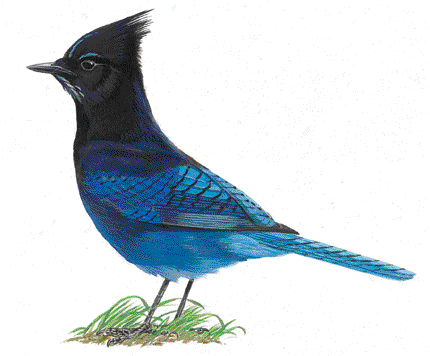Steller’s jay is a common bird of western North America with deep blue and black feathers and a crested head. Its range covers the Pacific Coast region from southeastern Alaska to central California and extends along the Rocky Mountains, through western Mexico, and into the highlands of Central America. Steller’s jays are relatives of crows. Like crows, Steller’s jays exhibit aggressive behavior. They have loud, harsh calls, quiet warbles, and they can mimic other birds. The Steller’s jay measures about 1 foot (30 centimeters) long. It is the provincial bird of British Columbia.

The head, chest, and back of the Steller’s jay appear black, and its belly, tail, rump, and wings are blue. Black bars mark the wings and tail. In the Northwest and along the coastal areas, blue streaks accent the forehead of the Steller’s jay. White forehead streaks and a white mark above the eye distinguish the Steller’s jay of the interior West. Southern populations have gray in the crest and on the back.
Steller’s jays eat a variety of foods, particularly fruits, nuts, seeds, and such small animals as insects and rodents. They also occasionally feed on the eggs and young from the nests of small birds. Steller’s jays often make their nest in conifer (cone-bearing) trees. Both the male and the female participate in the site selection and building of the nest. Mud holds together the bulky, cup-shaped nest, which may consist of leaves, moss, twigs, and weeds. Nests usually contain three to five bluish-green eggs with small dark spots.
Steller’s jays generally stay within the same range the year around. However, they sometimes migrate from high to low altitudes in the winter when food can be scarce.
The Steller’s jay takes its name from the German naturalist Georg Wilhelm Steller, who accompanied Vitus Bering’s ill-fated Russian expedition to Alaska. During a visit to Kayak Island in the early 1740’s, Steller first described the bird.
